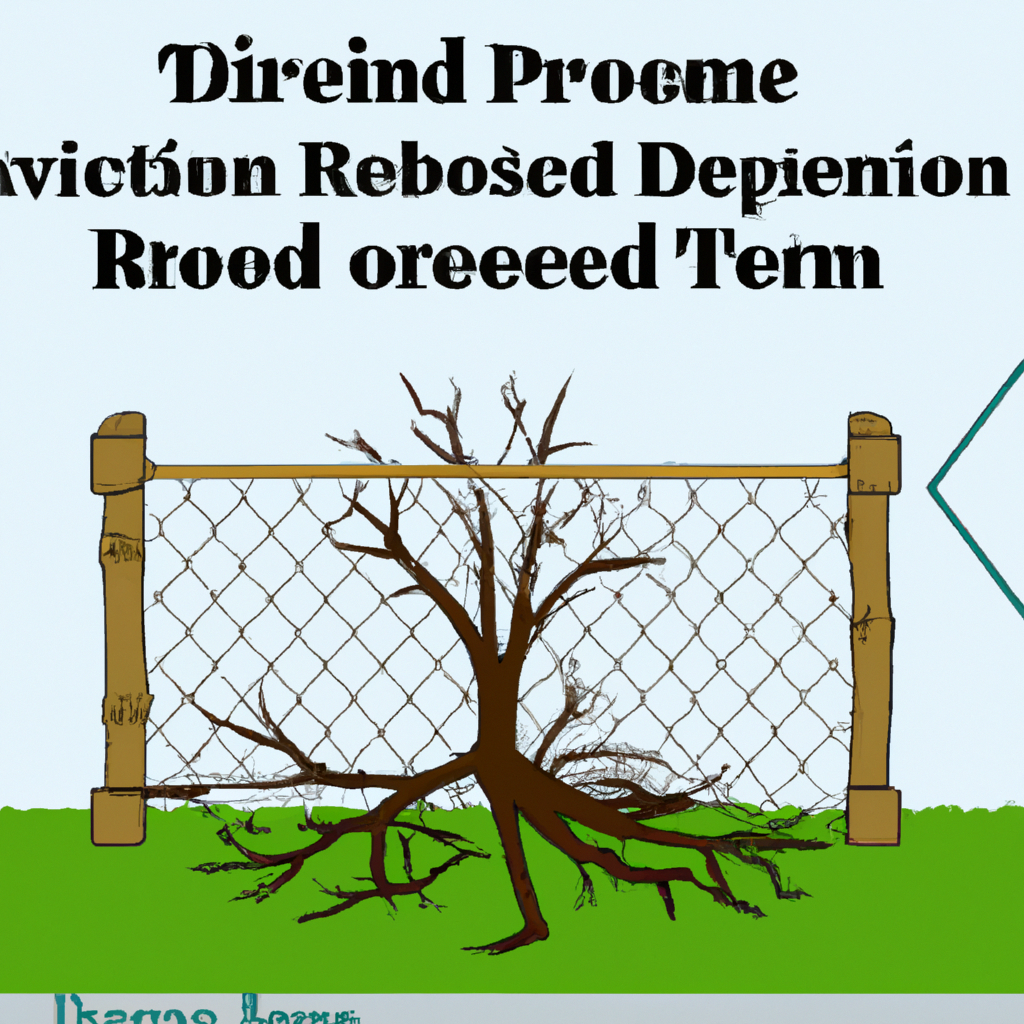In the world of fences, it is essential to understand the potential damage that tree roots can cause. In this article, we will explore how to prevent fence damage from tree roots and provide practical advice to ensure the longevity and stability of your fences. From understanding the signs of tree root damage to implementing preventive measures, we will guide you through the necessary steps to protect your fences from this common issue. So if you want to keep your fences intact and avoid costly repairs, keep reading to learn all about preventing fence damage from tree roots.
Types of Fences
Wooden Fences
Wooden fences are a classic choice for many homeowners due to their natural beauty and versatility. They come in various styles, such as picket fences, privacy fences, and split rail fences, allowing you to choose the one that suits your needs and preferences. Wooden fences can be customized to fit different property sizes and shapes, making them a popular option for both residential and commercial properties. However, they require regular maintenance, including painting or staining and occasional repairs, to ensure their longevity.
Chain-Link Fences
Chain-link fences are known for their affordability and durability. They consist of a woven metal wire mesh that provides security while allowing visibility. Chain-link fences are commonly used for residential and commercial properties, sports fields, and animal enclosures due to their low maintenance requirements. While they may not offer as much privacy as other fence types, they are an excellent option if security and functionality are your primary concerns.
Vinyl Fences
Vinyl fences have gained popularity in recent years due to their durability and low maintenance nature. They are made from polyvinyl chloride (PVC) and come in various styles, including privacy fences, picket fences, and ranch-style fences. Vinyl fences are resistant to rot, pests, and UV rays, making them a long-lasting choice for homeowners. They are available in a range of colors and textures, allowing you to find a design that complements your property.
Metal Fences
Metal fences, such as wrought iron and aluminum fences, offer a combination of strength, security, and an elegant aesthetic. Wrought iron fences are known for their intricate designs and classic appeal, while aluminum fences are lightweight and require minimal maintenance. Metal fences are often used for decorative purposes, as well as to provide security and define property boundaries. They are durable and can withstand harsh weather conditions, making them a long-term investment.
Wrought Iron Fences
Wrought iron fences are known for their timeless elegance and strength. They are typically crafted with intricate designs and ornamental details, adding a touch of sophistication to any property. Wrought iron fences require regular maintenance to prevent rusting, such as painting or applying a protective coating. While they may be more expensive than other fence types, their durability and visual appeal make them a popular choice for homeowners who value aesthetics.
Aluminum Fences
Aluminum fences offer the look of wrought iron without the high cost and maintenance requirements. They are lightweight, easy to install, and resistant to rust and corrosion. Aluminum fences are available in a variety of styles and colors, allowing homeowners to find the perfect design that matches their property’s theme. Due to their durability and versatility, aluminum fences are suitable for both residential and commercial properties.
Bamboo Fences
Bamboo fences are an eco-friendly and aesthetically pleasing option for homeowners. They are made from sustainable bamboo and are known for their natural beauty and durability. Bamboo fences provide privacy and can serve as a stylish backdrop for gardens or outdoor living spaces. While bamboo fences require occasional maintenance, such as cleaning and resealing, they offer a unique and environmentally conscious alternative to traditional fence materials.
Farm Fences
Farm fences, also known as agricultural fences, are designed to enclose and protect livestock or agricultural fields. They come in various types, including post and rail fences, woven wire fences, and electric fences. Farm fences are built to withstand the wear and tear of farm life and provide security for animals and crops. The type of farm fence chosen depends on factors such as the type of animals being contained, property size, and budget.
Privacy Fences
Privacy fences are specifically designed to block visibility and create a secluded and peaceful outdoor space. They are typically taller than other fence types and have little to no gaps between the panels, ensuring maximum privacy. Privacy fences can be made from various materials, such as wood, vinyl, or metal, allowing homeowners to choose the one that fits their style and budget. These fences are commonly used in residential areas to create a private backyard oasis.
Picket Fences
Picket fences are a traditional and charming choice for homeowners who want to add a touch of nostalgia to their property. They are characterized by their evenly spaced vertical boards, known as pickets, which can be pointed, rounded, or flat-topped. Picket fences are often made from wood, but they can also be constructed using vinyl or metal materials. They are popular for their aesthetic appeal and their ability to create boundaries without completely blocking the view.
And now, let’s move on to the factors to consider when choosing a fence.

Factors to Consider When Choosing a Fence
Purpose of the Fence
The first and most important factor to consider when choosing a fence is its purpose. Are you looking for privacy, security, decoration, or a combination of these? Understanding your specific needs will help you determine the best type and style of fence that will fulfill your requirements.
Budget
Your budget plays a crucial role in determining the type of fence you can afford. Different fence materials come at various price points, so it’s essential to have a clear budget in mind. Keep in mind that while some fence types may have a higher upfront cost, they may require less maintenance and have a longer lifespan, translating to cost savings in the long run.
Durability
Consider the durability of the fence material you choose. Factors such as weather conditions, exposure to sunlight, and potential damage from pests or ground movement can affect the lifespan of a fence. For example, metal fences tend to be more durable and resistant to damage, while wooden fences may require more maintenance to prevent rot or decay.
Maintenance
Think about the level of maintenance you are willing to commit to your fence. Some materials require regular upkeep, such as painting, staining, or applying sealants, while others are virtually maintenance-free. Take into account your time, energy, and resources available for fence maintenance when selecting the right material.
Security
If security is a concern for you, consider fence options that provide a higher level of protection. Solid privacy fences or fences with features like barbed wire or electric elements can enhance security and deter intruders. Additionally, the height and design of the fence should be considered to ensure it serves its intended purpose effectively.
Aesthetic Appeal
Fences can have a significant impact on the overall look and feel of your property. Consider the architectural style of your home and the surrounding landscape when choosing a fence. Certain materials, such as wrought iron or bamboo, might be better suited for a specific aesthetic, while others, like vinyl, can be customized to match your desired style.
Local Regulations
Before installing a fence, it’s crucial to research and understand any local regulations or restrictions that may govern fence type, height, or location. Local homeowners’ associations, city ordinances, or neighborhood covenants may have specific guidelines that need to be followed. Failure to comply with these regulations can result in costly fines or the requirement to remove and reinstall the fence.
Property Size and Shape
The size and shape of your property should be taken into consideration when choosing a fence. Larger properties may require more fencing materials and installation time, affecting your budget and timeline. Additionally, irregularly shaped lots may require custom fence designs or adjustments to accommodate the property’s unique layout.
Architectural Considerations
The architectural style of your home and surrounding structures should also influence your fence choice. A fence that complements the architectural elements of your property can enhance its overall curb appeal. If your property has specific design features or historical significance, you may want to select a fence style that complements and enhances those aspects.
Climatic Conditions
Consider the climate in your area when selecting a fence material. Certain materials, such as wood, may be prone to weathering, rotting, or warping in regions with high humidity or extreme temperature fluctuations. Other materials, like vinyl or metal, may be more resilient and suitable for areas with harsh weather conditions.
Now that you have considered the factors and chosen the right fence for your needs, it’s essential to understand how to prevent fence damage from tree roots.

Preventing Fence Damage
Identifying Tree Species
Start by identifying the tree species on your property. Different tree species have varying root growth patterns and characteristics that can affect nearby fences. By knowing the specific trees you have, you can better understand their potential impact on your fence and take appropriate preventive measures.
Determining Root Spread
Understanding the spread of tree roots is crucial in preventing fence damage. Tree roots can extend far beyond the dripline (the area directly beneath the outermost branches). Measure the distance between the tree and your fence to determine if there is a potential risk of root damage.
Proper Tree Planting Distance
When planting new trees, it’s important to consider the recommended planting distance from existing or proposed fences. Research optimal spacing guidelines for the specific tree species you are planting. By maintaining an appropriate distance, you can minimize the chances of future fence damage.
Root Barrier Installation
Root barriers can be installed to redirect tree roots away from fences. These barriers are typically made of rigid plastic or metal and are buried underground between the tree and the fence. The width and depth of the root barrier should match the expected root spread of the tree. Proper installation and maintenance of root barriers can effectively prevent root damage to fences.
Regular Tree Maintenance
Regular tree maintenance is essential to prevent fence damage caused by roots. This includes regular trimming and pruning of tree branches, removing dead or decaying branches, and assessing the overall health and stability of the tree. By keeping trees healthy and balanced, you can reduce the risk of root interference with fences.
Trimming Overhanging Branches
Overhanging tree branches can pose a risk to fences, especially during storms or windy conditions. Identify overhanging branches that are in close proximity to your fence and trim them back appropriately. This will help prevent branches from falling and damaging the fence.
Preventing Moisture Accumulation
Moisture can weaken fences and contribute to rot or decay. Ensure proper drainage around your fence by ensuring the ground slopes away from the fence and keeping gutters and downspouts clear of obstructions. Additionally, avoid overwatering plants near the fence, as excessive moisture can seep into the fence materials.
Monitoring Fence Stability
Regularly inspect your fence for signs of stability issues. Check for any movement or sagging of fence posts, as this can indicate root damage or soil erosion. Also, observe for any warping or shifting of fence panels, which could be a result of tree roots pushing against the fence.
Repairing Damaged Fences
If you notice any damage to your fence caused by tree roots, it’s important to address it promptly. Assess the extent of the damage and determine if repairs or replacements are necessary. This may involve replacing rotted wood, strengthening weak points, or realigning misaligned fence panels. Repairing damaged fences ensures their longevity and prevents further issues.
Consulting Professionals
When dealing with fence damage caused by tree roots, it may be beneficial to consult professionals. Arborists or tree care specialists can provide expertise in assessing tree health, recommending preventive measures, and safely performing tree maintenance. Additionally, fence installation experts and landscape architects can offer guidance on fence materials, designs, and proper installation techniques.
Now, let’s answer some frequently asked questions about fences and tree root damage.

Frequently Asked Questions
Can tree roots damage my fence?
Yes, tree roots can potentially damage fences, especially if they come into contact with the fence posts or panels. The extent of the damage can vary depending on factors such as tree species, root spread, and the age of the trees.
How far apart should trees be planted from a fence?
The recommended planting distance between trees and fences can vary depending on the tree species and its expected root spread. Research the specific planting guidelines for the trees you are considering to ensure an appropriate distance.
What is the best way to prevent fence damage from tree roots?
Preventing fence damage from tree roots involves understanding the tree species, determining root spread, installing root barriers, regular tree maintenance, trimming overhanging branches, preventing moisture accumulation, monitoring fence stability, and repairing any damage promptly.
How often should I trim overhanging branches near my fence?
It is recommended to trim overhanging branches near your fence regularly, especially if they are in close proximity. The frequency of trimming can depend on the growth rate of the tree and the potential risk of branches falling on the fence.
What are the signs of fence damage caused by roots?
Signs of fence damage caused by roots can include leaning or sagging fence posts, cracked or weakened fence panels, misalignment of fence panels, or visible root growth around or beneath the fence.
Can tree roots grow under concrete or other solid surfaces?
Yes, tree roots have the potential to grow under concrete or other solid surfaces. The growth of tree roots is typically driven by the availability of water and nutrients, and they can exploit any gaps or cracks in solid surfaces.
Are there any specific tree species that are less likely to damage fences?
Some tree species have shallow or non-invasive root systems that are less likely to damage fences. Examples include fruit trees, some species of maple, and certain varieties of ornamental shrubs. Consult with arborists or tree experts to determine suitable tree species for your specific situation.
Do root barriers guarantee complete protection for fences?
While root barriers can be effective in redirecting tree roots away from fences, they do not guarantee complete protection. In some cases, tree roots may find alternative paths or exert pressure on the fence from a distance. Regular monitoring and maintenance are still necessary to ensure the fence’s integrity.
Should I consult a professional for fence damage caused by roots?
Consulting a professional, such as an arborist or fence installation expert, can be beneficial when dealing with fence damage caused by roots. They can provide expert advice on tree health, preventive measures, and fence repairs or replacements.
Is there a way to repair a fence damaged by tree roots without removing the trees?
In some cases, it may be possible to repair a fence damaged by tree roots without removing the trees. This can include reinforcing or replacing fence components, realigning fence panels, and addressing any underlying soil conditions. Consulting professionals can help determine the best approach based on your specific situation.
| Question | Answer |
|---|---|
| Can tree roots damage my fence? | Yes, tree roots can potentially damage fences, especially if they come into contact with the fence posts or panels. The extent of the damage can vary depending on factors such as tree species, root spread, and the age of the trees. |
| How far apart should trees be planted from a fence? | The recommended planting distance between trees and fences can vary depending on the tree species and its expected root spread. Research the specific planting guidelines for the trees you are considering to ensure an appropriate distance. |
| What is the best way to prevent fence damage from tree roots? | Preventing fence damage from tree roots involves understanding the tree species, determining root spread, installing root barriers, regular tree maintenance, trimming overhanging branches, preventing moisture accumulation, monitoring fence stability, and repairing any damage promptly. |
| How often should I trim overhanging branches near my fence? | It is recommended to trim overhanging branches near your fence regularly, especially if they are in close proximity. The frequency of trimming can depend on the growth rate of the tree and the potential risk of branches falling on the fence. |
| What are the signs of fence damage caused by roots? | Signs of fence damage caused by roots can include leaning or sagging fence posts, cracked or weakened fence panels, misalignment of fence panels, or visible root growth around or beneath the fence. |
| Can tree roots grow under concrete or other solid surfaces? | Yes, tree roots have the potential to grow under concrete or other solid surfaces. The growth of tree roots is typically driven by the availability of water and nutrients, and they can exploit any gaps or cracks in solid surfaces. |
| Are there any specific tree species that are less likely to damage fences? | Some tree species have shallow or non-invasive root systems that are less likely to damage fences. Examples include fruit trees, some species of maple, and certain varieties of ornamental shrubs. Consult with arborists or tree experts to determine suitable tree species for your specific situation. |
| Do root barriers guarantee complete protection for fences? | While root barriers can be effective in redirecting tree roots away from fences, they do not guarantee complete protection. In some cases, tree roots may find alternative paths or exert pressure on the fence from a distance. Regular monitoring and maintenance are still necessary to ensure the fence’s integrity. |
| Should I consult a professional for fence damage caused by roots? | Consulting a professional, such as an arborist or fence installation expert, can be beneficial when dealing with fence damage caused by roots. They can provide expert advice on tree health, preventive measures, and fence repairs or replacements. |
| Is there a way to repair a fence damaged by tree roots without removing the trees? | In some cases, it may be possible to repair a fence damaged by tree roots without removing the trees. This can include reinforcing or replacing fence components, realigning fence panels, and addressing any underlying soil conditions. Consulting professionals can help determine the best approach based on your specific situation. |

